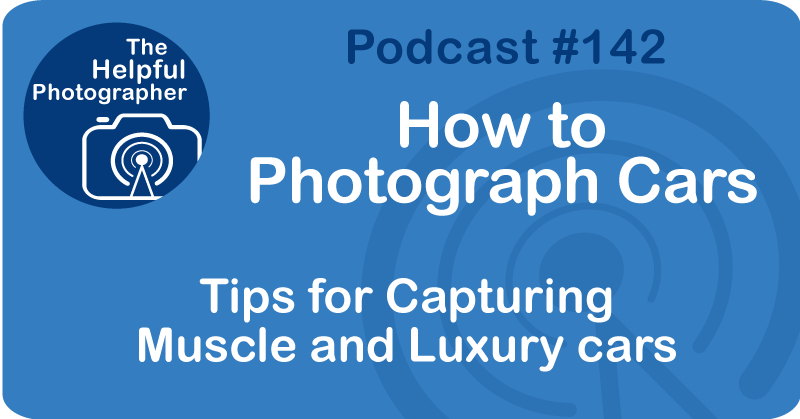How to Photograph Cars #142

This pod is for James in Melbourne. James wants to know how to photograph cars. Now, you might be wondering, what do I know about shooting cars, right? You wouldn't be wrong to ask that question because none of my current work would indicate that I have any experience with this. But you see, I went to Art Center College of Design in Pasadena, California, which has not only a photography department, but also one of the very few automotive design departments in the world.
As a matter of fact, Art Center was the first school in the world with an automotive design department. Yep, they created it. And as a way to put myself through school, I actually did a lot of portfolio shoots for automotive design students, which gave me a chance to shoot a lot of cars. Well, they weren't real cars, but they were scale model cars, which is basically the real thing, but smaller. And it also gave me a chance to get to know the designers and what goes on inside their heads as they're designing these cars. Later on, I was hired by Volkswagen Audi's Advanced Design Studio to photograph their full-scale model cars.
So there you have it. And drawing from that experience, I want to share some of the things that I learned, and maybe it'll help you photograph cars better too. When it comes to photographing anything, the first thing you need to do is to make a decision. What are you trying to convey about that subject? Since this is a pod about cars, let's talk cars. Is it an elegant luxury car or a bold, aggressive muscle car?
If it's a muscle car, it's all about being big, bold, and aggressive, right? You'll want to capture that energy. And to do that, my first instinct is to get low. Move to the front of the car, shoot up at it from a low angle. This makes the car look even more powerful and dominating. You'll also want to shoot from a 3/4 angle and go wide, something like 16 millimeters. This means standing at the front corner of the car and positioning yourself so you get a glimpse of the side, but the focus will still be the massive front grille. It will make the car look more domineering.
Now, if you're shooting a luxury car, the approach changes. Luxury cars are more about elegance and sleek lines. In this case, you might want to step back and move to the side of the car a bit more. Luxury cars often have beautiful side profiles that highlight those graceful lines. You don't need to get low here. You want to showcase the sophistication of the design. So, play around with angles that show off the side and maybe a bit of the front as well.
Another thing you can focus on is details, like the hood ornament. If you're shooting a Rolls Royce, for example, you might want to go wide and get close to that hood ornament, using a lens as wide as even 10mm. This will push the ornament into the forefront of the shot while still adding some of the windshield and hood for context. Alternatively, you can back up and use a longer lens, say 100 or 200mm, to compress the object and isolate the ornament against the car's lines.
Handles are another interesting detail. You can shoot them close up and wide to make them pop, or back up and use a long lens to capture how the lines of the car flow seamlessly with the rest of its design. The front grille is another key feature. Designers put a lot of thought into how that grille looks, especially in modern cars. For a strong, bold shot, get in close and use a wide lens to really emphasize the grille's design. You'll probably want to use something under 20mm. It'll spread the details out and make them feel more prominent in the frame.
And while a lot of photographers concentrate on the front, don't forget about the back of the car. The rear end is just as important because that's the last thing people see when the car drives away, and designers know that. You can apply the same shooting principles as with the front. Get low, shoot wide, or back up and compress the shot.
And now, the most important factor in any shot—lighting. Good lighting can make or break every photo. If you're shooting your own car or a friend's car, you have the luxury of waiting for the perfect light. Think sunrise or sunset for the beautiful golden glow. Try to avoid harsh shadows, especially from trees, because they can ruin a clean shot.
If you really want to take it up a notch, think about how car ads look. Ever notice how the road is always wet in those photos? They actually bring out tanker trucks to wet the pavement. The wet surface makes the ground darker and bounces light back into the car, which gives the vehicle a clean, polished look. You can create this effect by wetting down the area where the car is parked.
Speaking of car ads, I highly recommend flipping through some magazines or visiting the car maker's website. Look at how they shoot their cars. These companies spend tens of thousands of dollars on professional photographers, so you can learn a lot just by studying their compositions and their angles.
In the end, the most important thing to keep in mind is what it is you want to convey about that car. Whether it's the power of a muscle car or the elegance of a luxury sedan, the angle, light, and details you focus on should reflect that idea.
Next week, I'm gonna talk about how to shoot a moving car.










